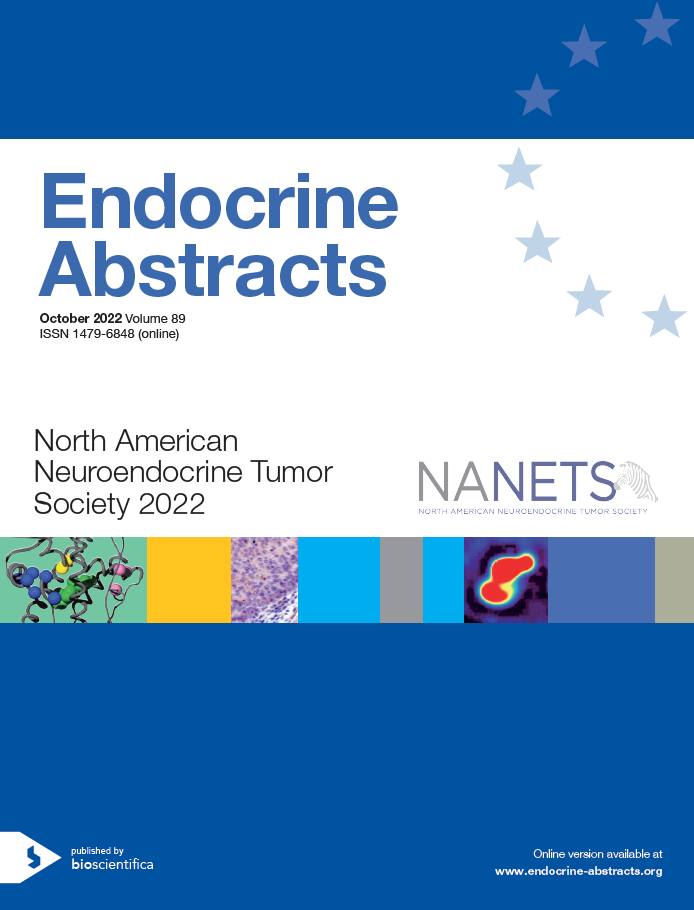15th Annual Multidisciplinary NET Medical Symposium NANETS 2022
Clinical – Surgery/Applied Pathology
ea0089c30 | Clinical – Surgery/Applied Pathology | NANETS2022
Liver-Directed Therapy of Neuroendocrine Liver Metastases
Meloche-Dumas Leamarie , Mercier Frederic , Barabash Victoria , Law Calvin , Coburn Natalie , Singh Simron , Myrehaug Sten , Chan Wing , Hallet Julie
ea0089c31 | Clinical – Surgery/Applied Pathology | NANETS2022
Goblet Cell Adenocarcinoma (GCA) of the Appendix: Interrogating Proteomics to Identify Potential Actionable Targets
Patel, MBBS, MD Krutika , Du, PhD Liping , Revetta, PhD Frank , Kay Washington, MD, PhD Mary , Berlin, MD Jordan , Das, MD, MSCI Satya
ea0089c32 | Clinical – Surgery/Applied Pathology | NANETS2022
Surgical Management of G3 Gastroenteropancreatic Neuroendocrine Neoplasms: A Systematic Review and Meta-Analysis
Ziogas, MD, MPH Ioannis A. , T. Tasoudis, MD Panagiotis , C. Borbon, MD Luis , K. Sherman, MD, FACS Scott , J. Breheny, MS, PhD Patrick , Chandrasekharan, MBBS Chandrikha , S. Dillon, MD Joseph , M. Bellizzi, MD Andrew , R. Howe, MD, FACS James
ea0089c33 | Clinical – Surgery/Applied Pathology | NANETS2022
High-Grade Pancreatic Neuroendocrine Neoplasms: Interobserver Diagnostic Accuracy and Relationship with Clinicopathological and Molecular Characteristics
Taherian, MD Mehran , Waters, MD Rebecca , Foo, MD Wai Chin , Maru, MD Dipen , Abraham, MD Susan C. , Rashid, MBBS, PhD Asif , Wang, MD, PhD Huamin , Wei, MD Dongguang , Taggart, MD Melissa W. , Chatterjee, MD Deyali
ea0089c34 | Clinical – Surgery/Applied Pathology | NANETS2022
Grade Creep and the Importance of Tissue Sampling: Changes in Ki-67 and Grade in Serial Neuroendocrine Tumor Samples
Byun Suzie , M. DePietro Daniel , Ackerman Daniel , P. Gade Terence , C. Soulen Michael
ea0089c35 | Clinical – Surgery/Applied Pathology | NANETS2022
Liver Directed Therapy is Associated with Improved Survival in Metastatic Gastroenteropancreatic Neuroendocrine Neoplasms with Concurrent Bone Metastasis
Limbach, MD Kristen E. , Mahuron, MD Kelly M. , Ituarte, PhD Philip H. G. , Kessler, MD Jonathan , Li, MD Daneng , Singh, MD Gagandeep
ea0089c37 | Clinical – Surgery/Applied Pathology | NANETS2022
Is There a Role for Surgical Resection of Grade 3 Neuroendocrine Neoplasms?
C. Borbon, MD Luis , G. Tran, MD Catherine , K. Sherman, MD Scott , Hien Ear, PhD Po , Chandrasekharan, MD Chandrikha , M. Bellizzi, MD Andrew , S. Dillon, MD Joseph , M. O'Dorisio, MD Thomas , R. Howe, MD James
ea0089c38 | Clinical – Surgery/Applied Pathology | NANETS2022
Increased Incidence, Prevalence, and Surgical Management of Enteropancreatic Neuroendocrine Tumors Is Associated with Improvements in Survival - A Contemporary Analysis
Concors, MD Seth J , Tzeng, MD Ching-Wei D , Ikoma MD Naruhiko , Kim MD Michael , Cao, MD Hop Tran , Lee, MD Jeffery E , Katz, MD Matthew HG , Maxwell, MD, MBA Jessica E
ea0089c39 | Clinical – Surgery/Applied Pathology | NANETS2022
Have We Accounted for Asians? A Critical Analysis of Racial Cancer Disparity Amongst Asian Pancreatic Neuroendocrine Tumor Patients
E McElroy, MD Katherine , Irfan, MD Ahmer , Reddy, MD Sushanth , Yates, PhD Clayton , Chen, MD, FACS Herbert , Bart Rose, MD J.
ea0089c40 | Clinical – Surgery/Applied Pathology | NANETS2022
TP53 Mutation Portends a Worse Overall Survival in Patients with Advanced Grade 3 Well-Differentiated Neuroendocrine Tumors
Joseph Nancy , Paciorek Alan , Khuong Le Bryan , Moon Farhana , Zhang Li , Bergsland Emily
ea0089c41 | Clinical – Surgery/Applied Pathology | NANETS2022
SSTR-2 Expression in Solid Tumors: An Immunohistochemistry Analysis
Chauhan Aman , Arnold Susanne , Bocklage Therese , Yan Donglin , Li Ning , Anthony Lowell , Allison Derek
ea0089c42 | Clinical – Surgery/Applied Pathology | NANETS2022
Small Intestinal NET Recurrence – When Why and How?
Pai Priya K. , Gudmundsdottir Hallbera , Cleary Sean P. , Halfdanarson Thorvardur R.
ea0089c43 | Clinical – Surgery/Applied Pathology | NANETS2022
Post-Operative Biochemical Surveillance Thresholds Can be Used to Monitor for Sympathetic Pheochromocytoma/Paraganglioma Recurrence and Metastasis
S Lui Michael , B Fisher Sarah , G Grubbs Elizabeth , D Perrier Nancy , G Waguespack Steven , Varghese Jeena , A Habra Mouhammed , Jimenez Camilo , H Graham Paul




